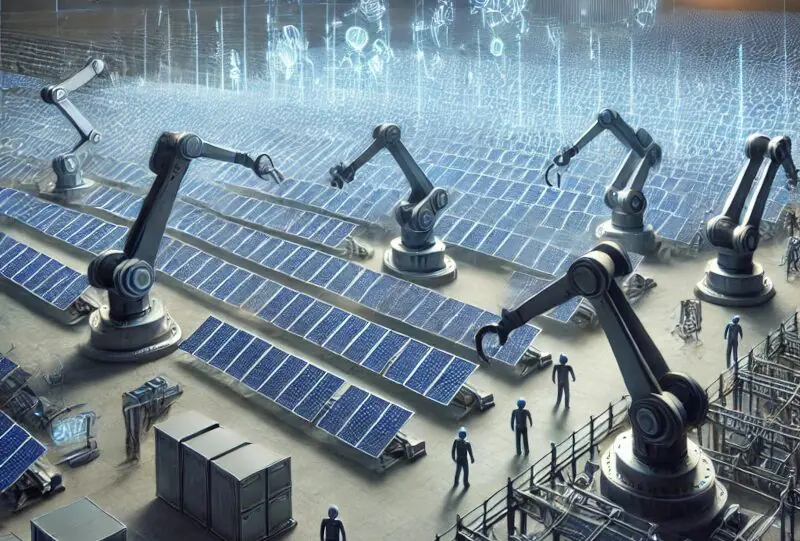The global energy transition is no longer a matter of speculation. It’s happening at a breakneck pace, driven by an undeniable economic reality: renewables are now cheaper and more scalable than fossil fuels.
But there’s a bottleneck. As much as the world wants to go all-in on solar, actually building these massive projects remains a logistical nightmare.
That’s where technology steps in. Automation, AI, and robotics are now reshaping how large-scale solar farms are developed, slashing costs, improving efficiency, and paving the way for an energy revolution.
This is the opportunity SoftBank (TYO: 9984) just jumped on. In March 2025, the Japanese tech investment giant bet $130 million on Terabase Energy, a California-based company that’s bringing automation to solar farm construction.
The move underscores a broader trend—tech-driven renewables are no longer an experiment. They’re the next frontier.
The Automation Breakthrough That Changes Everything
Solar power has had a spectacular run over the past decade. The cost of solar panels has plummeted by over 80% since 2010, and installations in the U.S. hit a record 40 GW in 2024 alone.
Yet the physical process of deploying utility-scale solar farms remains cumbersome. The industry still relies heavily on manual labor, requiring teams to install thousands, sometimes millions, of panels across vast stretches of land.
Unlike traditional power plants, solar farms need to cover huge areas to generate significant electricity. This means that instead of a single centralized structure, solar projects require the precise and repeated installation of millions of components (panels, inverters, trackers, and mounting systems – over hundreds or thousands of acres).
These logistical challenges translate to higher costs and longer build times. A single 100 MW solar farm can take 9 to 12 months to complete, with construction labor accounting for up to 15% of total project costs.
The manual nature of the work also increases exposure to project delays, workforce shortages, and inefficiencies.
This is where Terabase Energy comes in. The company was founded in 2019 with a singular mission: automate the construction of solar farms to make them faster, cheaper, and more scalable. At the heart of this effort is its Terafab™ system, a robotics-assisted solar panel assembly line designed to streamline installations.
By eliminating manual lifting and automating component placement, Terafab™ has already helped deploy 40 MW of solar capacity across several commercial projects in the U.S. The plan is to scale that number into the hundreds of megawatts by 2026.
Terabase’s approach is modeled after factory automation. Instead of assembling panels and racking on-site under unpredictable conditions, Terafab™ pre-assembles components in a controlled environment before deploying them rapidly in the field. This drastically cuts down labor costs and improves build precision. Industry experts estimate that robotic-assisted solar farm construction could reduce installation costs by 20-30% while shortening project timelines by several months.
Why SoftBank (TYO: 9984) is Betting on Terabase
SoftBank’s $130 million investment isn’t just about backing another solar company. It’s a strategic play on the intersection of renewable energy and automation. The funding comes through SoftBank (TYO: 9984) Vision Fund 2, the same investment arm that’s placed bets on AI, autonomous systems, and digital transformation projects across various industries.
But why now? The global race to scale up renewable energy has created an urgent need for new solutions. The U.S. alone has over 700 GW of solar projects in interconnection queues, and global solar capacity is expected to triple by 2030, reaching 5,000 GW.
However, the industry’s ability to deliver these projects on time is in doubt, thanks to supply chain constraints, workforce shortages, and inefficiencies in construction.
SoftBank’s bet on Terabase aligns with a larger trend: the increasing automation of physical infrastructure development. The same logic that led to robotic factories in automotive manufacturing and AI-driven logistics in e-commerce is now being applied to solar energy. If Terabase succeeds, it could reshape the economics of solar deployment, making utility-scale projects faster, cheaper, and more predictable.
Beyond automation, SoftBank (TYO: 9984) sees the potential for software-driven optimization in renewables. Terabase’s technology stack isn’t just about robots. It also includes digital twin modeling, AI-driven project planning, and real-time site monitoring.
These tools allow solar developers to simulate and optimize projects before construction even begins, improving efficiency and reducing costly rework.
A Transformational Shift for the Solar Industry
The implications of this move extend far beyond a single company.
The push toward automation in solar construction addresses one of the most pressing challenges in the energy sector: labor shortages. With the U.S. solar workforce already struggling to meet demand, robotic assembly and AI-powered project management could be the key to unlocking faster deployment.
Furthermore, this investment lands at a time when energy demand from AI data centers, electric vehicles, and industrial electrification is exploding. Data center energy consumption alone is expected to double by 2030, driving even greater urgency for rapid renewable energy expansion.
The long-term impact? If automated solar farm construction becomes standard practice, it could unlock gigawatts of new capacity that would otherwise be delayed or too expensive to build.
Countries pushing for aggressive clean energy targets, such as the U.S. (which aims for 100% carbon-free electricity by 2035) and China (which plans to install 1,200 GW of solar and wind by 2030), will increasingly look for solutions like Terabase to scale up deployment without hitting workforce or cost barriers.
SoftBank’s play signals something bigger. This isn’t just about renewable energy. It’s about the technological transformation of an industry that’s at the center of the global economy.




